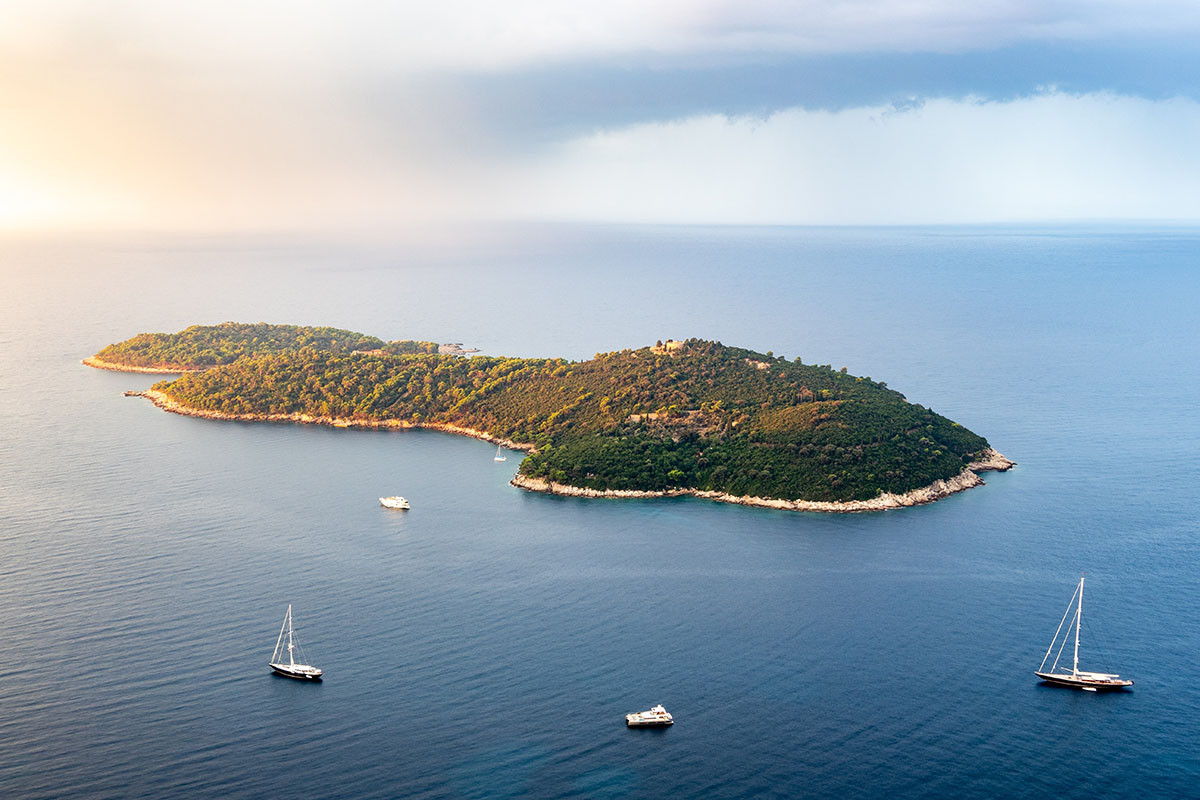
Croatia has once again become one of Europe’s top tourist destinations since its War of Independence in early 1990’s.
Like many other European cities, Croatia boasts its own share of medieval cities and historic ruins, but what makes Croatia exceptional is its wealth of stunning natural attractions, 10 UNESCO sites, the spectacular Adriatic coastline with its breathtaking islands.
Let’s countdown our 10 favorite places to visit starting with the Krka National Park.
10. Krka National Park
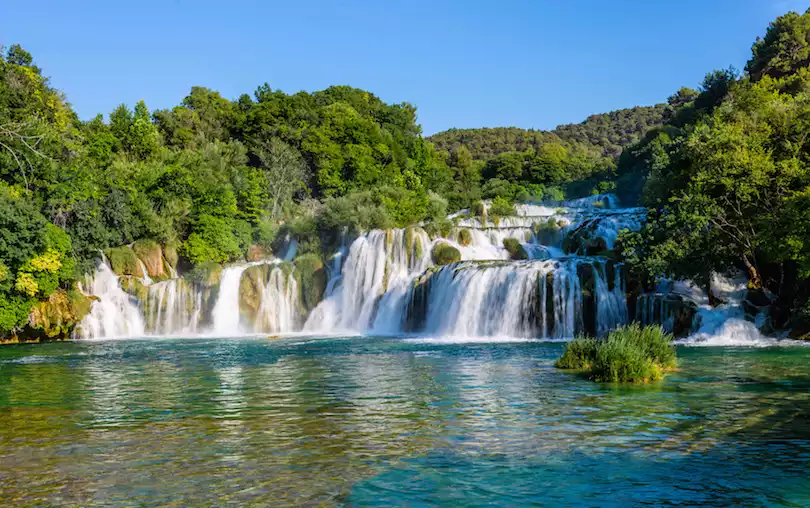
Located in the Central Dalmatian region of Croatia, the Krka National Park is a protected area of spectacular natural scenery, wildlife and historical sites. Situated along the Krka River within Sibenik Knin County, the national park is best known for its numerous gushing waterfalls and natural pools of crystal clear blue green waters.
Easily accessible by car and bus via Split to Sibenik, the national park offers well maintained walkways and boat excursions for sightseeing. The most popular attraction of the park is the network of cascading waterfalls.
Numerous trails lead around the waterfalls which are perfect for fabulous photo opportunities. Some of the falls plunge into natural pools, where swimming is permitted. In addition to the waterfalls, the surrounding scenery of lush vegetation, flowers and glimpses of wildlife enhance the natural beauty of the park.
Other places to visit inside the park include historic monasteries and archaeological sites of Roman settlements and medieval fortresses. In addition to all this, there are plenty of tourist facilities such restaurants, museums and picnic areas.
9. Zagreb

Croatia's capital city and also its largest city, Zagreb is a vibrant metropolis packed with plenty of historic and modern tourist attractions. Located in the northwestern part of Croatia, Zagreb dates back to the 2nd century AD when a diocese was first established by Hungarian King Ladislaus. Modern day Zargreb is a sprawling cosmopolitan city and the heart of Croatian culture, academics and government.
The city is divided into an Upper and Lower Town, with Upper Town being the historic core where tourists can walk down cobblestone streets and visit old, medieval churches, towers and palaces.
Some of the city’s most important sites include the Stone Gate with a painting of the Virgin Mary, which survived a major fire in 1731. Ban Jelacic Square is the city’s main square and is the setting of historic architecture and restaurants. The traditional open-air market, Dolac Market, features many stalls selling fresh produce, clothing and local handicrafts. Along the Strossmayer’s Walkway, tourists can see artists, musicians and other street performers.
There are about 20 permanent or seasonal theatres and stages. The Croatian National Theater in Zagreb was built in 1895 and opened by emperor Franz Joseph I of Austria. The most renowned concert hall named "Vatroslav Lisinski", after the composer of the first Croatian opera, was built in 1973.
8. Korcula
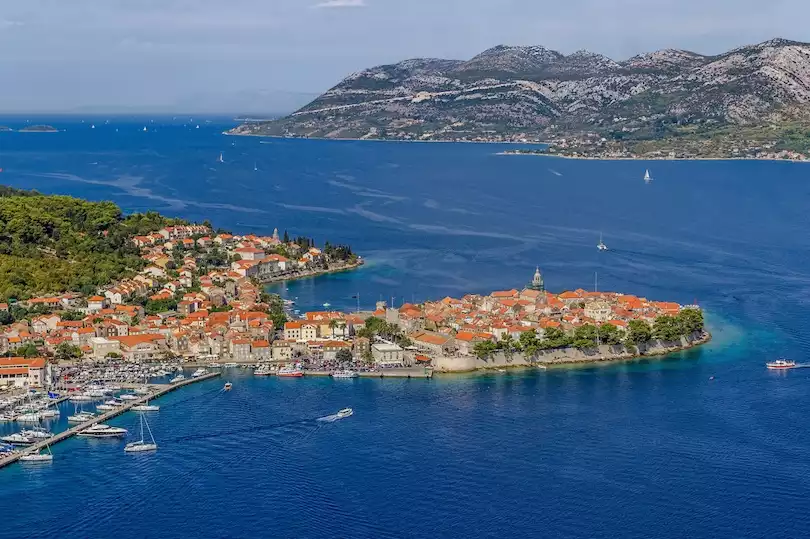
Best known as the alleged birthplace of the famous merchant traveler, Marco Polo, Korcula is a 50 km island located off Croatia’s Adriatic Coast. Easily reached by ferries from major Croatian cities, Split and Dubrovnik, Korucla is steeped in picturesque landscapes, quaint towns, rich history and enchanting traditions.
Korcula is comprised of lush green forests, vineyards, olive groves and charming villages such as Blato, known for its baroque churches and long boulevard of lime trees, shops, restaurants and hotels. Popular for its sandy white beaches, Lambarda also features several archaeological remains of Greek and Roman settlements. The island’s main town, Korucla Town, is a historic, walled town with Venetian Renaissance architecture, colorful markets and plenty of tourist facilities.
Unique to Korcula are its lively cultural traditions and festivals that have been practiced for centuries. Most famous of these is the Kumpanija ritual involving chivalry dances and mock medieval battles with real swords. Another of the island’s popular events is the Marco Polo Fest, a pop music celebration held in honor of the historic explorer.
Korcula’s cuisine is among its top attractions are the local staples of lamb, cured ham and fresh seafood grilled with olive oil and parsley which should be experienced. The island’s indigenous wines, Posip and Rukatac are also very popular.
Korčula is linked to the mainland by a regular ferry service that runs between Dominče, just outside Korčula Town and Orebić. There are numerous other local ferry services including one linking Vela Luka and Lastovo.The main Croatian ferry operator Jadrolinija runs a service linking Korčula Town with Rijeka, Split, Hvar, Mljet, Dubrovnik and (from May to September) Bari. An operator Linijska nacionalna plovidba runs a seasonal service linking Korčula with Drvenik.
7. Pula

Pula is the largest city in Istria County, Croatia, and the eighth-largest city in the country, situated at the southern tip of the Istrian peninsula. It is known for its multitude of ancient Roman buildings, the most famous of which is the Pula Arena, one of the best preserved Roman amphitheaters. The city has a long tradition of wine making, fishing, shipbuilding, and tourism. It was the administrative centre of Istria from ancient Roman times until superseded by Pazin in 1991.
Pula is a popular destination that has been attracting tourists as far back as ancient Roman times when fans flocked the city’s amphitheater to watch gladiator fights. Having been ruled by various government powers over the centuries, Pula today belongs to Croatia, and is best known for its wealth of Roman ruins and mix of cultures.
Pula is a vibrant city offering plenty to see and do. The city’s star attraction is the 1st century Roman amphitheater. Known as the Arena, the amphitheater is one of the largest and best-preserved of its kind in the world. Every July, the Arena is host to the Pula Film Festival. Other significant historic structures include the old city gates, arches, monasteries, a Byzantine chapel, a Venetian fortress and the Forum, the city’s main square, which is surrounded by Roman architecture and temples.
The nearby Brijuni National Park and farming villages are also great places to visit, while the turquoise coastal waters and sandy beaches offer fishing, sailing, swimming, snorkeling and diving.
6. Zadar
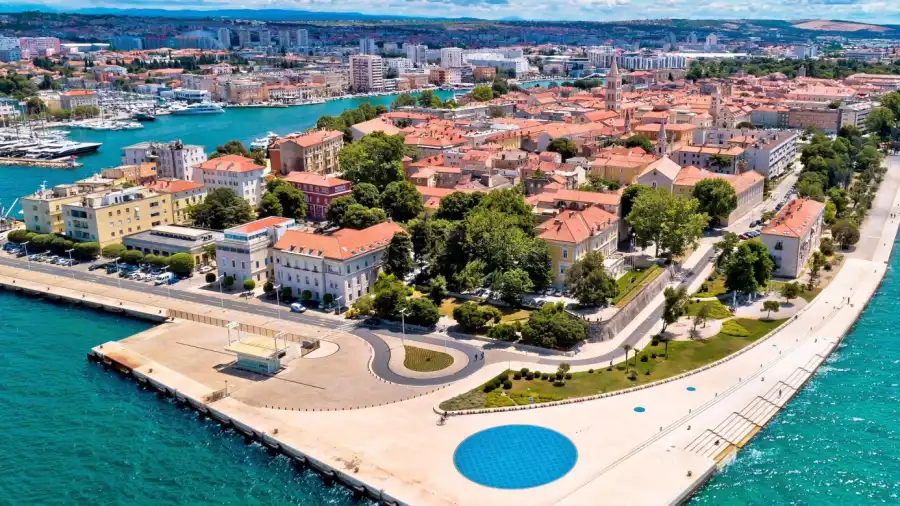
Zadar is the oldest continuously inhabited Croatian city. It is situated on the Adriatic Sea, at the northwestern part of Ravni Kotari region. Zadar serves as the seat of Zadar County and of the wider northern Dalmatian region. It is a three thousand-year old city situated on a beautiful coastline rich in history is sure to draw tourists.
At the heart of the city is the Old Town, which can be explored by foot. The historic district offers some amazing sightseeing attractions including: Roman ruins, medieval architecture and numerous old churches. Some of the city’s most popular sites are the Roman Forum, the circular St. Donat’s Church, 12th century St. Anastasia Cathedral, the Archaeological Museum and the University of Zadar, which is one of the oldest in Europe.
Tourists will find numerous beautiful beaches all along Zadar’s coastline enabling you to sunbathe, swim and enjoy a variety of water sports. Two unique attractions that are not to be missed in Zadar are the Sea Organ and the Sun Salutation, man-made marvels that use nature to create impressive light and sound experiences. Situated on Zadar’s beautiful seaside riva promenade, the Sea Organ allows the sea to make its own music as waves push air through 35 underground pipes. After absorbing energy from the sun all day, the Sun Salutation produces a colorful light show at night.
5. Rovinj
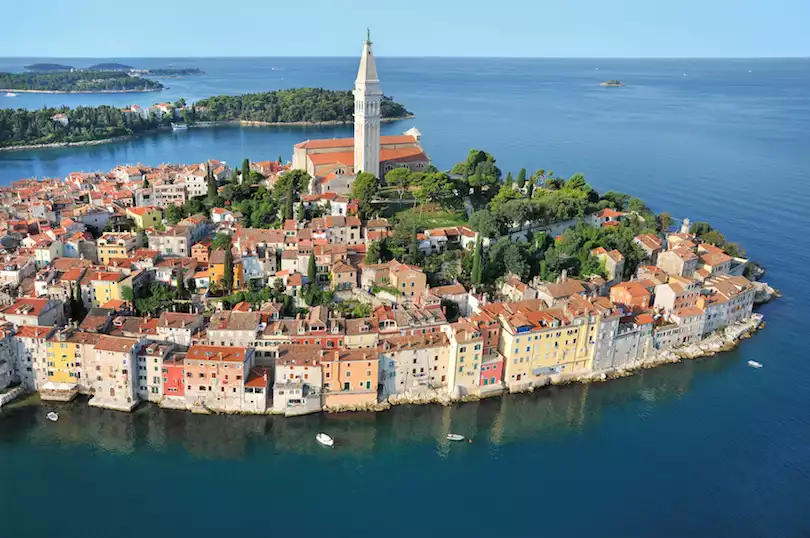
Rovinj is a city in Croatia situated on the north Adriatic Sea. Located on the western coast of the Istrian peninsula, it is a popular tourist resort and an active fishing port. Istriot, a Romance language once widely spoken in this part of Istria, is still spoken by some of the residents. The town is officially bilingual, Italian and Croatian, hence both town names are official and equal.
It may appear to be a quiet fishing village on the surface, but Rovinj has an old world charm and surrounding natural beauty that makes it a top tourist destination. Rovinj is an archipelago of 20 islands and its Old Town set on a small peninsula. Historic sites, beautiful landscapes, fabulous dining and modern tourist facilities are just some of Rovinj’s many treasures.
Some of the Old Town’s historic gems include seven medieval city gates, the 12th century town clock, the Balbi Arch and St. Euphemia’s Basilica, an imposing baroque church packed with many stunning art works. Also worth seeing are the Valdibora Farmer’s Market, the scenic harbor, Carrera Street with its many shops and art galleries, and Grisia Street, which is lined with artists and souvenir vendors.
Rovinj is surrounded by spectacular landscapes that provide plenty of outdoor recreation. Rovinj’s beaches are regarded as some of Croatia’s most beautiful. The calm coves present excellent opportunities for swimming and scuba diving, while the outlying islands offer scenic wonders like pristine forests, the Lim Fjord and the Zlatni Rt Forest Park where visitors can enjoy hiking, cycling, rock climbing and more.
4. Split
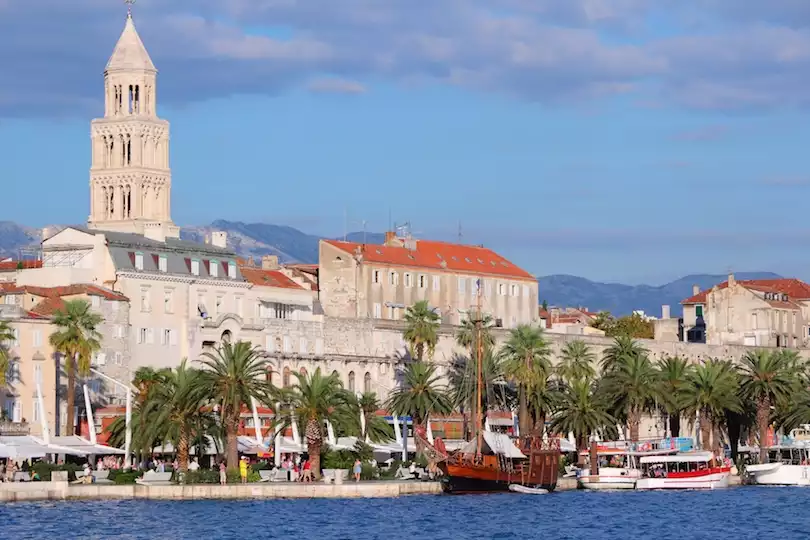
Split is the second largest city of Croatia and the largest city in the region of Dalmatia. It lies on the eastern shore of the Adriatic Sea and is spread over a central peninsula and its surroundings. An intraregional transport hub and popular tourist destination, the city is linked to the Adriatic islands and the Apennine Peninsula.
In 1979, the historic center of Split was included into the UNESCO list of World Heritage Sites and has has been nicknamed the “Mediterranean Flower,”. Its old Roman architecture and orange-roofed houses create a striking contrast with the turquoise sea and dramatic coastal mountains. Abundant sunshine, impressive sights, dining and nightlife all make Split a popular tourist destination and it also serves as a transportation hub to many of the Adriatic islands.
The main attraction is its historic core of beautiful Gothic and Renaissance architecture of which the Diocletian’s Palace is the crown jewel. Built between 298 and 305 AD, this Roman Emperor palace complex is more like a small city itself with a maze of marble walkways and buildings containing shops, cafes and bars. Inside the palace are many other striking structures like St. Duje’s Cathedral, Jupiter’s Temple, Peristil Square and two original Egyptian sphinx monuments.
The Museum of Croatian Archaeological Monuments (Croatian: Muzej hrvatskih arheoloških spomenika) is the only museum in Croatia dedicated to researching and presenting cultural artifacts of the Croats in the Middle Ages, between the 7th and 15th centuries, particularly the time of the early medieval Croatian state from 9th to 12th century. The collection of early medieval wicker, clay figurines, and old Croatian Latin epigraphic monuments is the largest collection of its kind in Europe.
3. Plitvice National Park
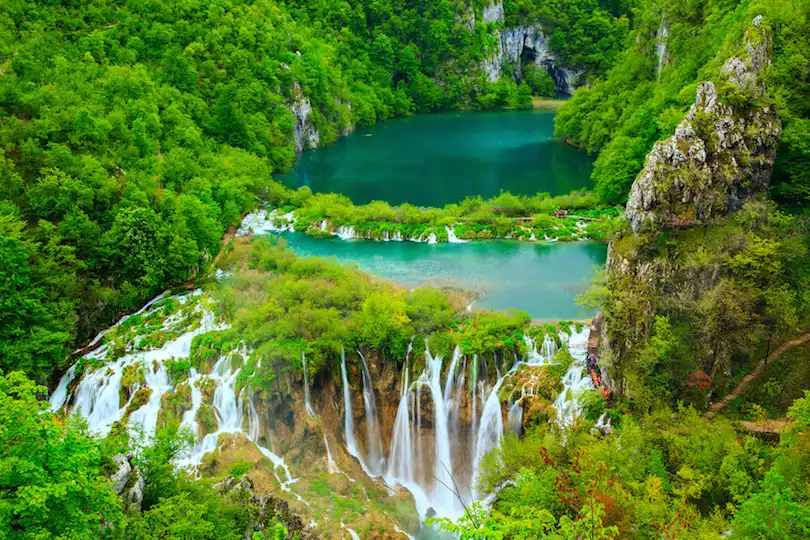
One of the most beautiful natural wonders in Croatia and all of Europe. Plitvice Lakes National Park is one of the oldest and largest national parks in Croatia. In 1979, Plitvice Lakes National Park was inscribed on the UNESCO World Heritage list, due to its outstanding and picturesque series of tufa lakes, caves, connected by waterfalls. The Plitvice National Park consists of several breathtaking lakes, waterfalls and lush forest. The park’s most notable features are the 16 interconnecting lakes that are divided into upper and lower clusters.
With its exceptional natural beauty, this area has always attracted nature lovers, and on 8 April 1949, it was proclaimed Croatia’s first national park. The process of tufa formation, which results in the building of the tufa, or travertine, barriers and resulted in the creation of the lakes, is the outstanding universal value, for which the Plitvice Lakes were internationally recognised on 26 October 1979 with their inscription onto the UNESCO World Heritage List
Visitors can explore the lakes and surrounding area by walking along the assortment of wooden walkways as well as by boat.
2. Hvar
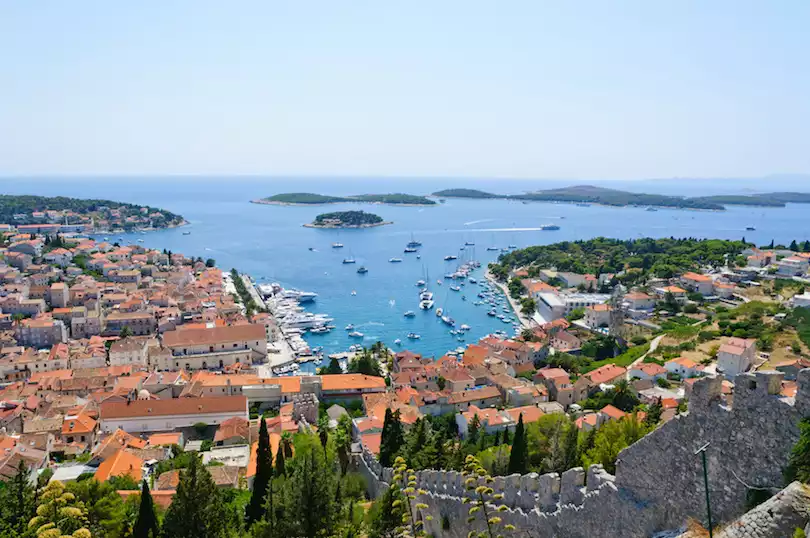
Hvar is one of the most popular tourist destinations in the Adriatic Sea. It is a beautiful Croatian island off the Dalmatian Coast, favored for its landscapes of spectacular beaches, lavender fields and vineyards.
Hvar Town is an attractive city featuring 13th century walls, marble stone streets, Gothic palaces, stunning churches and an imposing old fortress. The town square is one of Croatia’s largest and most beautiful, surrounded by many historic structures like the 17th century Arsenal and the Cathedral of St. Stephen. Hvar town is the main tourist center. It features a large public square (St Stephen's Square) that is open to the sea. During the tourist season, the port is filled with luxury yachts and sailboats. All-night discos attract large crowds of young visitors.
The natural beauty of the island offers outdoor recreation and adventure, from hiking in the cliffs to swimming in the secluded coves and beaches. Boat rentals and tours are available for those wishing to explore the nearby Pakleni Islands. Archaeological sites on the island offer views of ancient artifacts and insight into Hvar’s Neolithic history. Grapceva Cave is well worth visiting to see its interesting formations. The charming villages dotting the lush countryside are great for experiencing the local culture.
Tourists to Hvar will find a large variety of restaurants ranging from Croatian to Mediterranean and European. At night, Hvar Town bursts into activity with parties, bars and night clubs with live music.
1. Dubrovnik
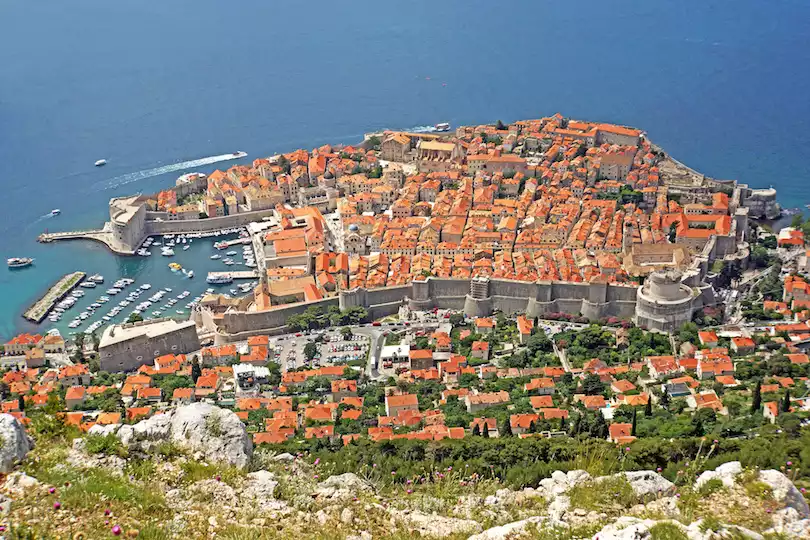
Nicknamed the “Pearl of the Adriatic,” the old city of Dubrovnik is one of the most prominent tourist destinations of the Mediterranean. Located at the southern tip of Croatia of the Adriatic Sea, Dubrovnik was established in the 7th century on maritime trade. The first set of walls to enclose the city was built in the 9th century. In the middle of the 14th century the 1.5m-thick defences were fortified with 15 square forts. The threat of attacks from the Turks in the 15th century prompted the city to strengthen the existing forts and add new ones, so that the entire old town was contained within a stone barrier 2km long and up to 25m high.
No visit to Dubrovnik would be complete without a walk around the spectacular city walls that encircle its Old Town. From the top, the view over the old town and the shimmering Adriatic is absolutely sublime. The azure waters are mesmerizing, while from above the maze of church steeples and terracotta roofs is the perfect setting for a fairy tale and features in the HBO series Game of Thrones episodes.
There are many beautiful places in the world, however the people of Dubrovnik claim their city to be the most beautiful. A warm southern climate, emerald green and dark blue crystal-clear sea with numerous coves and bays, sandy beaches and steep reefs decorated with the lushest Mediterranean flora.
Visit, explore and enjoy!


